Sir John Monash, Personal Files Book 13, 1 June - 1 July 1916, Part 6
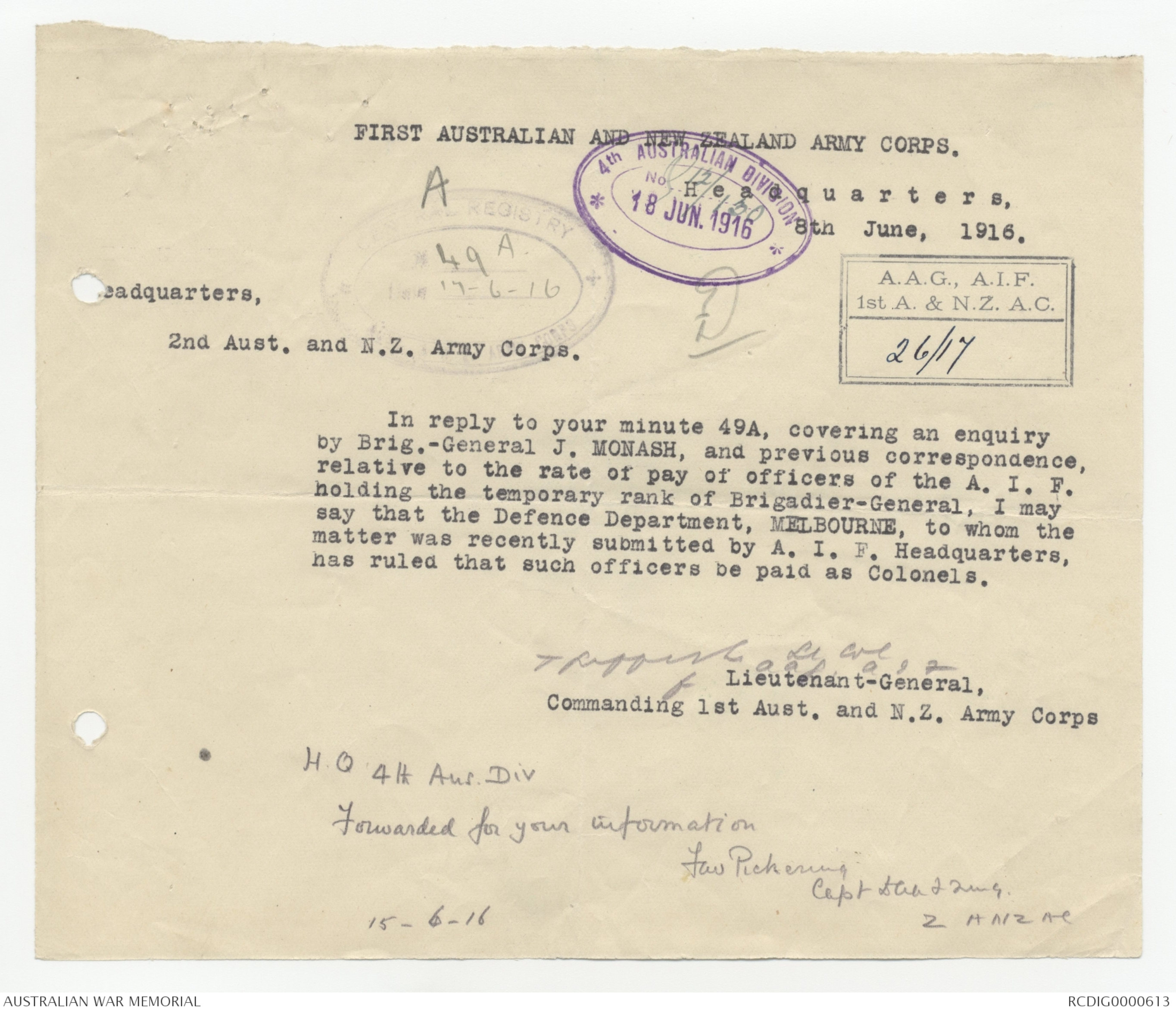
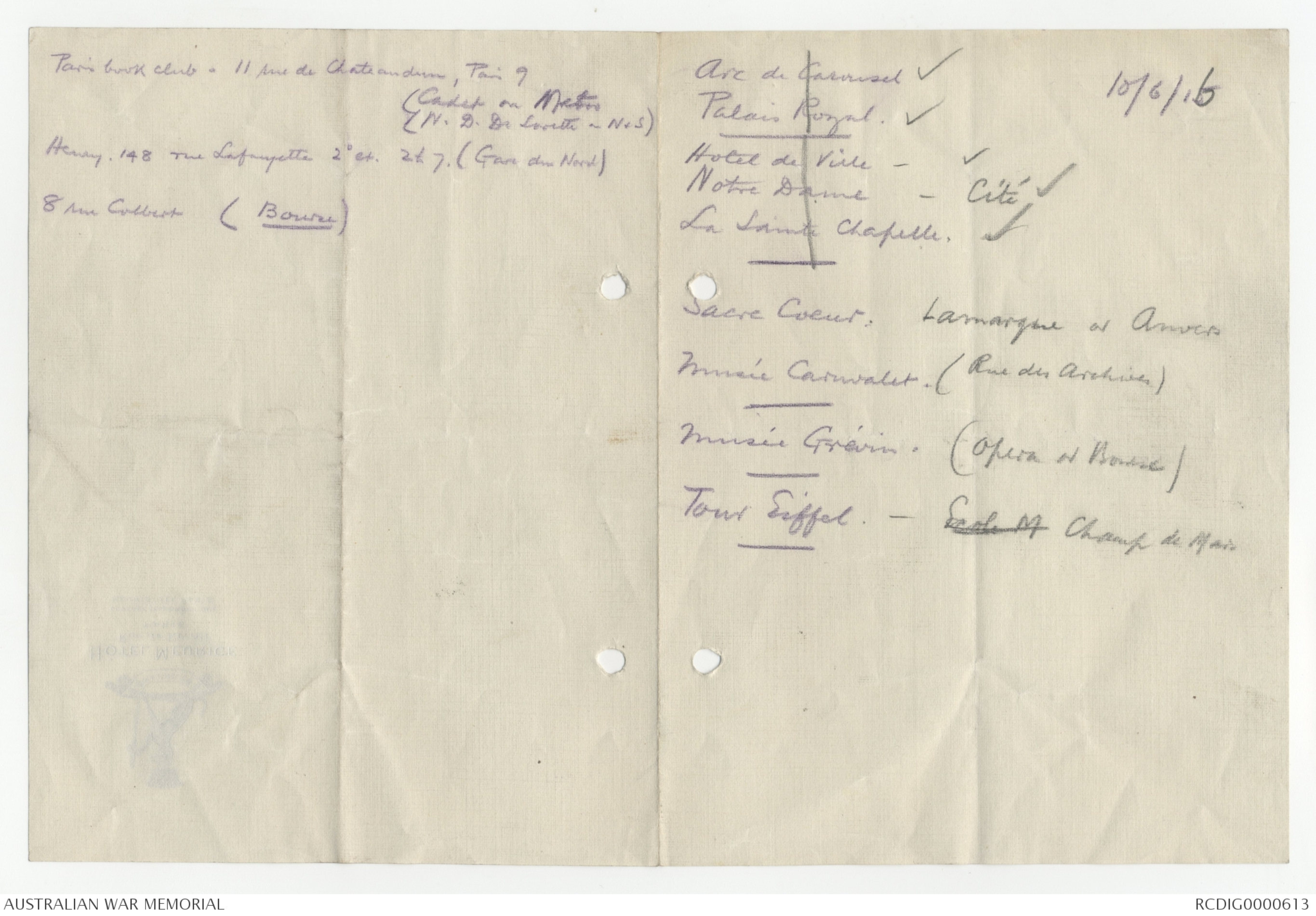
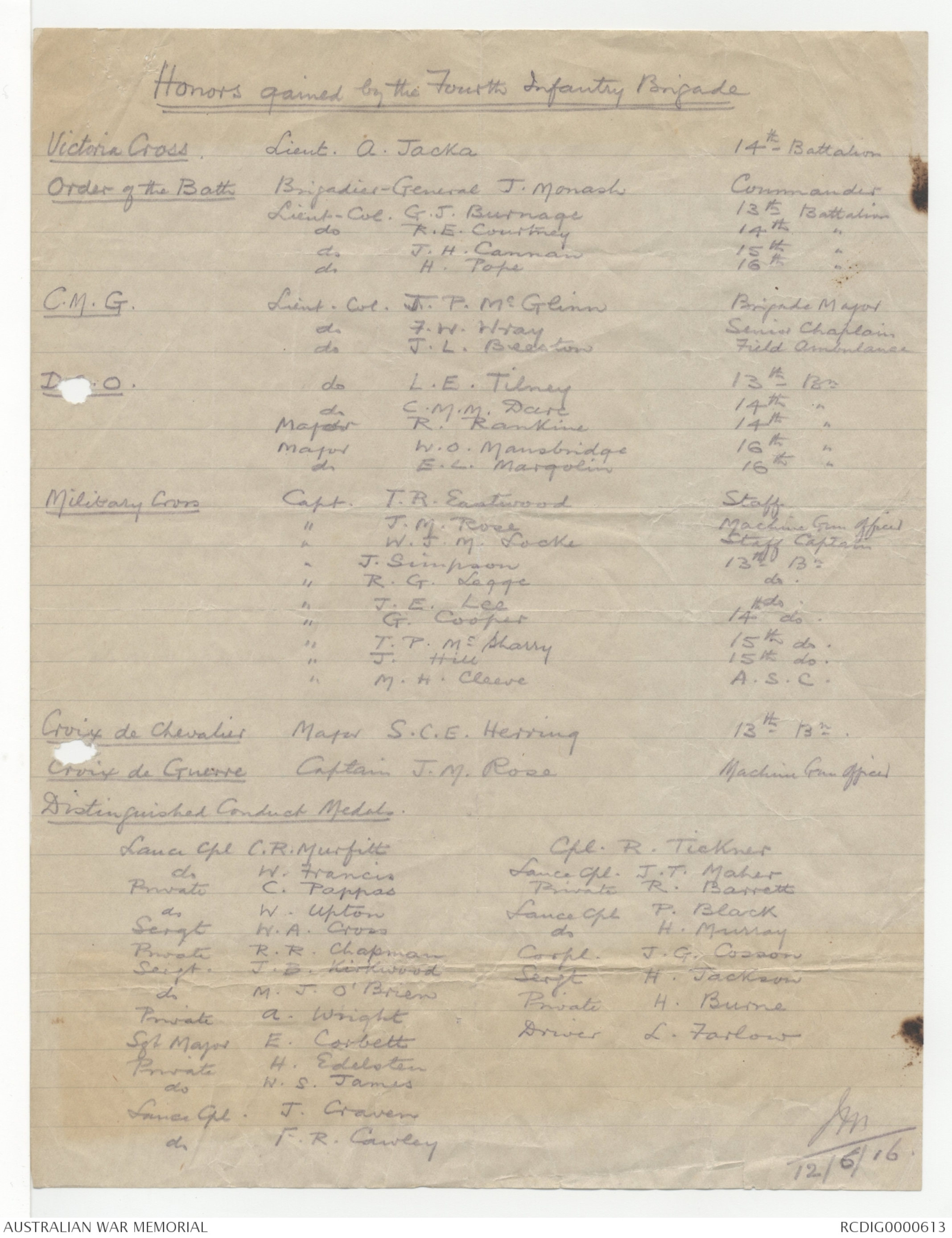
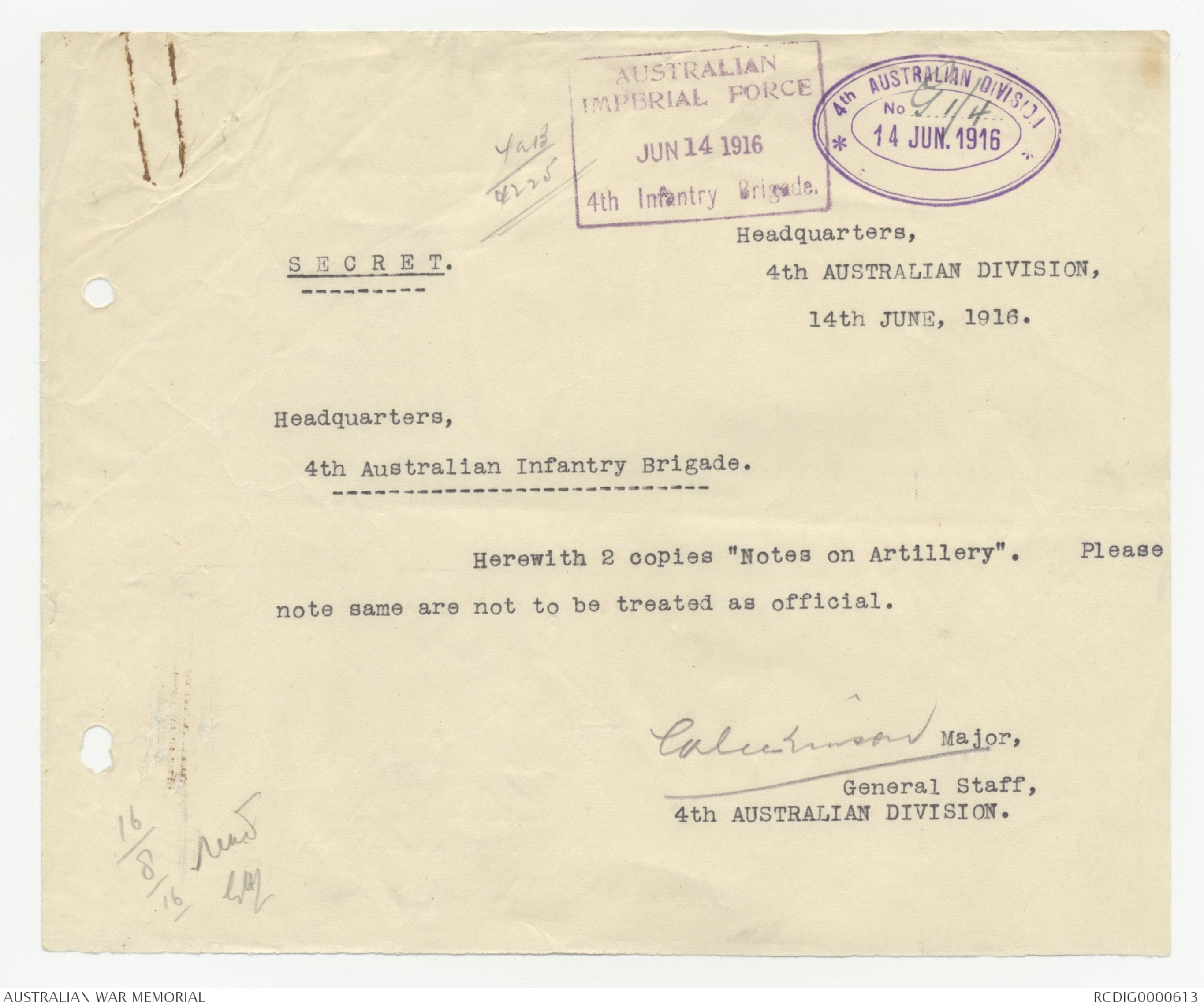
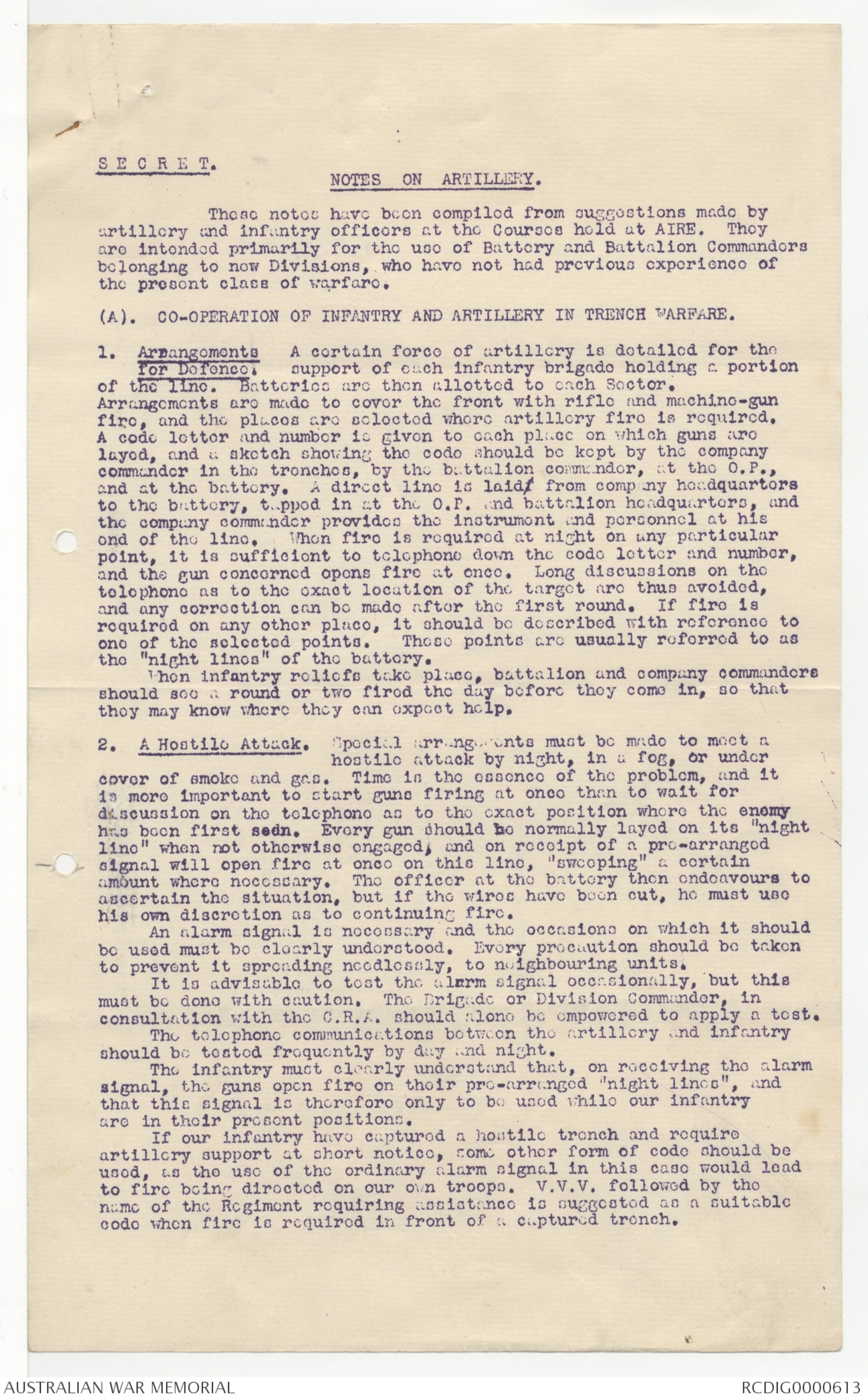
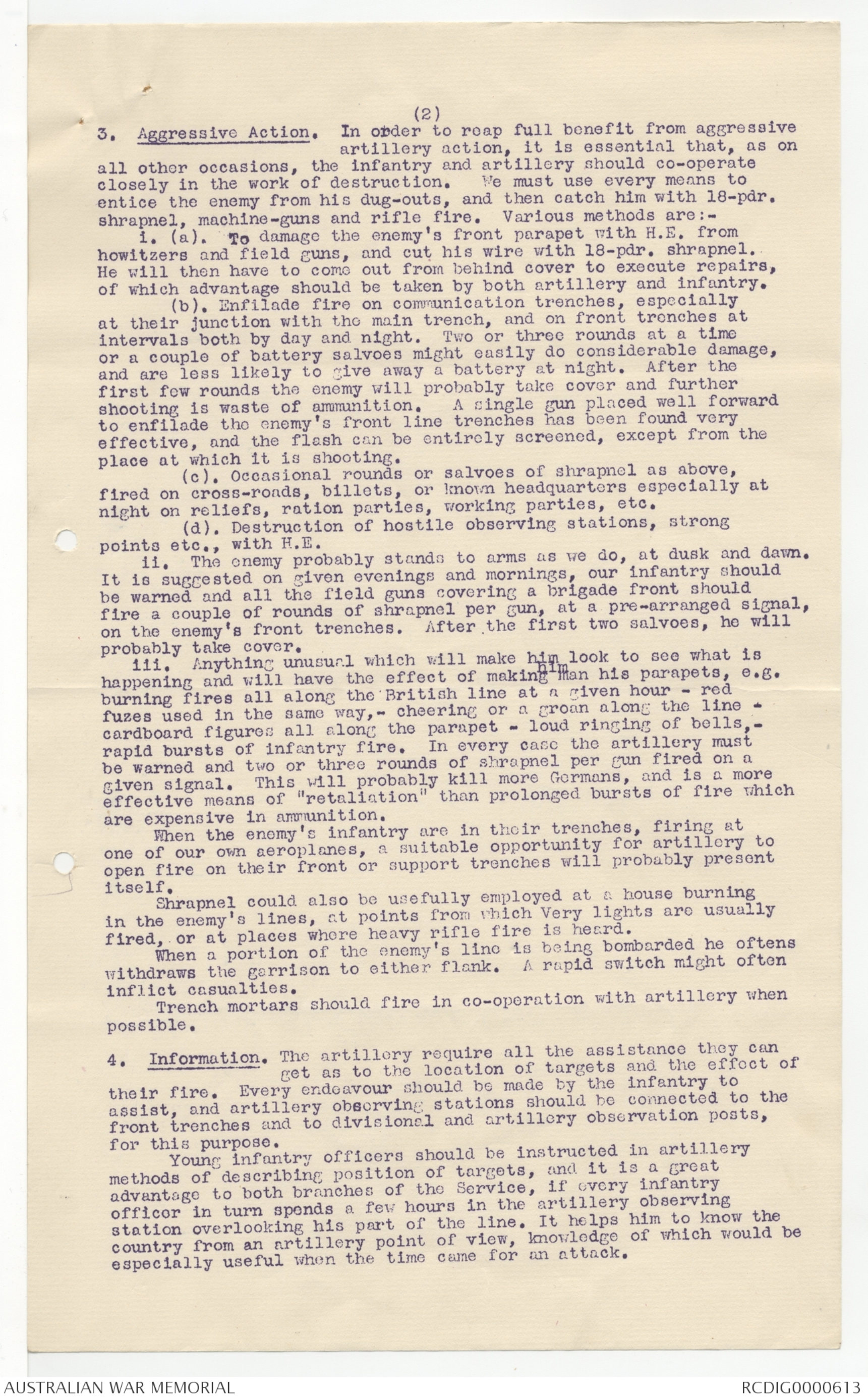
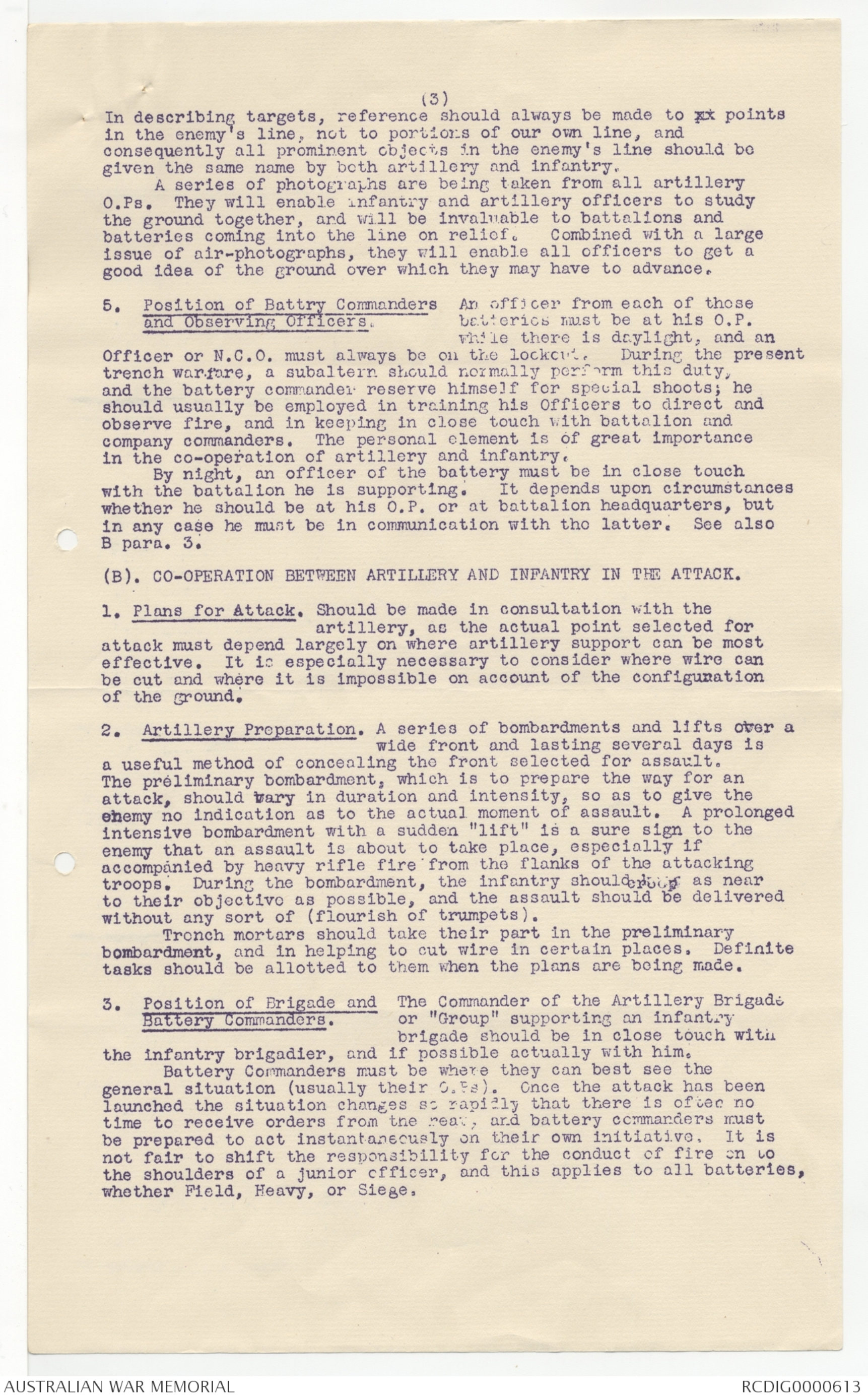
FIRST AUSTRALIAN AND NEW ZEALAND ARMY CORPS.
[*CENTRAL REGISTRY
49 A.
Date 17-6-16
A&NZ ARMY CORPS*]
[*4th AUSTRALIAN DIVISION
No Q 12/130
18 JUN. 1916*]
[*A.A.G., A.I.F.
1st A. & N.Z.A.C.
26/17*]
[*D*]
Headquarters,
8th June, 1916.
Headquarters,
2nd Aust. and N.Z. Army Corps.
In reply to your minute 49A, covering an enquiry
by Brig.-General J. MONASH, and previous correspondence,
relative to the rate of pay of officers of the A.I.F
holding the temporary rank of Brigadier-General, I may
say that the Defence Department, MELBOURNE, to whom the
matter was recently submitted by A. I. F. Headquarters,
has ruled that such officers be paid as Colonels.
T Lippish Lt. Col aaj, A I F
for Lieutenant-General,
Commanding 1st Aust. and N.Z. Army Corps
[*HQ 4th Aus. Div
Forwarded for your information.
FW Pickering
Capt DAA & 2mg
2 ANZAC*]
15-6-16
Paris book club - 11 rue de Chateaudun, Pari 9
(Cadet on Metro
(N. D. De Lovette on N&S)
Henry. 148 rue Lafayette 2o et. 2 to 7. (Gare du Nord)
8 rue Colbert (Bourse)
10/6/16
Arc de Carousel √
Palais Royal. √
——————————
Hotel de Ville - √
Notre Dame - Cité √
La Sainte Chapelle. √
——————————
Sacre Coeur. Lamarque or Anvers
Musée Carnavalet. (Rue des Archives)
——————————
Musée Grévin. (Opera or Bourse )
——————————
Tour Eiffel - Scale M Champ de Mars
Honors gained by the Fourth Infantry Brigade
| Victoria Cross | Lieut. A. Jacka | 14th Battalion |
| Order of the Bath | Brigadier-General J. Monash | Commander |
| Lieut-Col G. J. Burnage | 13th Battalion | |
| do R. E. Courtney | 14th " | |
| do J. H. Cannan | 15th " | |
| do H. Pope | 16th " | |
| C.M.G. | Lieut. Col. J. P. McGlinn | Brigade Major |
| do F. W. Wray | Senior Chaplain | |
| do J. L. Beeston | Field Ambulance | |
| D.S.O. | do L. E. Tilney | 13th Bn |
| do C. M. M. Dare | 14th " | |
| Major R. Rankine | 14th " | |
| Major W. O. Mansbridge | 16th " | |
| do E. L. Margolin | 16th " | |
| Military Cross | Capt T. R. Eastwood | Staff |
| " J. M. Rose | Machine Gun Officer | |
| " W. J. M. Locke | Staff Captain | |
| " J. Simpson | 13th Bn | |
| " R. G. Legge | do | |
| " J. E. Lee | do | |
| " G. Cooper | 14th do | |
| " T. P. McSharry | 15th do | |
| " J. Hill | 15th do | |
| " M. H. Cleeve | A.S.C. | |
| Croix de Chevalier | Major S. C. E. Herring | 13th Bn |
| Croix de Guerre | Captain J. M. Rose | Machine Gun Officer |
Distinguished Conduct Medals
Lance Cpl. C. R. Murfitt Cpl R. Tickner
do W. Francis Lance Cpl. J. T. Maher
Private C. Pappas Private R. Barrett
do W. Upton Lance Cpl. P Black
Sergt W. A. Cross do H. Murray
Private R. R. Chapman Corpl. J. G. Cosson
Sergt. J. B. Kirkwood Sergt H. Jackson
do M. J. O'Brien Private H. Burne
Private A. Wright Driver L. Farlow
Sgt Major E Corbett
Private H. Edelsten
do W. S. James
Lance Cpl. J. Craven
do F. R. Cawley
JM
12/6/16
[*AUSTRALIAN IMPERIAL FORCE
JUN 14 1916
4th Infantry Brigade*]
[*4th Australian Division
No G1/4
14 Jun 1916*]
4AB/42255
SECRET.
Headquarters,
4th AUSTRALIAN DIVISION,
14th JUNE, 1916
Headquarters,
4th Australian Infantry Brigade.
Herewith 2 copies "Notes on Artillery". Please
note same are not to be treated as official.
Calces Kinson Major,
General Staff
4th AUSTRALIAN DIVISION
16/8/16 read GM
SECRET.
NOTES ON ARTILLERY.
These notes have been compiled from suggestions made by
artillery and infantry officers at the Courses held at AIRE. They
are intended primarily for the use of Battery and Battalion Commanders
belonging to now Divisions, who have not had previous experience of
the present class of warfare.
(A). CO-OPERATION OF INFANTRY AND ARTILLERY IN TRENCH WARFARE.
- Arrangements for Defence. A certain force of artillery is detailed for the
support of each infantry brigade holding a portion
of the line. Batteries are then allotted to each Sector.
Arrangements are made to cover the front with rifle and machine-gun
fire, and the places are selected where artillery fire is required.
A code letter and number is given to each place on which guns are
layed, and a sketch showing the code should be kept by the company
commander in the trenches, by the battalion commander, at the O.P.,
and at the battery. A direct line is laidf from company headquarters
to the battery, tapped in at the O. P. and battalion headquarters, and
the company commander provides the instrument and personnel at his
end of the line. When fire is required at night on any particular
point, it is sufficient to telephone down the code letter and number,
and the gun concerned opens fire at once. Long discussions on the
telephone as to the exact location of the target are thus avoided,
and any correction can be made after the first round. If fire is
required on any other place, it should be described with reference to
one of the selected points. Those points are usually referred to as
the "night lines" of the battery.
When infantry reliefs take place, battalion and company commanders
should see a round or two fired the day before they come in, so that
they may know where they can expect help.
2. A Hostile Attack. Special arrangements must be made to meet a
hostile attack by night, in a fog, or under
cover of smoke and gas. Time is the essence of the problem, and it
is more important to start guns firing at once than to wait for
discussion on the telephone as to the exact position where the enemy
has been first seen. Every gun should be normally layed on its "night
line" when not otherwise engaged, and on receipt of a pre-arranged
signal will open fire at once on this line, "sweeping" a certain
amount where necessary. The officer at the battery then endeavours to
ascertain the situation, but if the wires have been cut, he must use
his own discretion as to continuing fire.
An alarm signal is necessary and the occasions on which it should
be used must be clearly understood. Every precaution should be taken
to prevent it spreading needlessly, to neighbouring units.
It is advisable to test the alarm signal occasionally, but this
must be done with caution. The Brigade or Division Commander, in
consultation with the C. R. A. should alone be empowered to apply a test.
The telephone communications between the artillery and infantry
should be tested frequently by day and night.
The infantry must clearly understand that, on receiving the alarm
signal, the guns open fire on their pre-arranged "night lines", and
that this signal is therefore only to be used while our infantry
are in their present positions.
In our infantry have captured a hostile trench and require
artillery support at short notice, some other form of code should be
used, as the use of the ordinary alarm signal in this case would lead
to fire being directed on our troops. V. V. V. followed by the
name of the Regiment requiring assistance is suggested as a suitable
code when fire is required in front of a captured trench.
(2)
3. Aggressive Action. In order to reap full benefit from aggressive
artillery action, it is essential that, as on
all other occasions, the infantry and artillery should co-operate
closely in the work of destruction. We must use every means to
entice the enemy from his dug-outs, and then catch him with 18-pdr.
shrapnel, machine-guns and rifle fire. Various methods are:-
i. (a). To damage the enemy's front parapet with H. E. from
howitzers and field guns, and cut his wire with 18-pdr. shrapnel.
He will then have to come out from behind cover to execute repairs,
of which advantage should be taken by both artillery and infantry.
(b). Enfilade fire on communication trenches, especially
at their junction with the main trench, and on front trenches at
intervals both by day and night. Two or three rounds at a time
or a couple of battery salvoes might easily do considerable damage,
and are less likely to give away a battery at night. After the
first few rounds the enemy will probably take cover and further
shooting is waste of ammunition. A single gun placed well forward
to enfilade the enemy's front line trenches has been found very
effective, and the flash can be entirely screened, expect from the
place at which it is shooting.
(c). Occasional rounds or salvoes of shrapnel as above,
fired on cross-roads, billets, or known headquarters especially at
night on reliefs, ration parties, working parties, etc.
(d). Destruction of hostile observing stations, strong
points etc., with H. E.
ii. The enemy probably stands to arms as we do, at dusk and dawn.
It is suggested on given evenings and mornings, our infantry should
be warned and all the field guns covering a brigade front should
fire a couple of rounds of shrapnel per gun, at a pre-arranged signal,
on the enemy's front trenches. After the first two salvoes, he will
probably take cover.
iii. Anything unusual which will make him look to see what is
happening and will have the effect of making ^him man his parapets, e.g.
burning fires all along the British line at a given hour - red
fuzes used in the same way, - cheering or a groan along the line -
cardboard figures all along the parapet - loud ringing of bells,-
rapid bursts of infantry fire. In every case the artillery must
be warned and two or three rounds of shrapnel per gun fired on a
given signal. This will probably kill more Germans, and is a more
effective means of "retaliation" than prolonged bursts of fire which
are expensive in ammunition.
When the enemy's infantry are in their trenches, firing at
one of our own aeroplanes, a suitable opportunity for artillery to
open fire on their front or support trenches will probably present
itself.
Shrapnel could also be usefully employed at a house burning
in the enemy's lines, at points from which Very lights are usually
fired, or at places where heavy rifle fire is heard.
When a portion of the enemy's line is being bombarded he oftens
withdraws the garrison to either flank. A rapid switch might often
inflict casualties.
Trench mortars should fire in co-operation with artillery when
possible.
4. Information. The artillery require all the assistance they can
get as to the location of targets and the effect of
their fire. Every endeavour should be made by the infantry to
assist, and artillery observing stations should be connected to the
front trenches and to divisional and artillery observation posts,
for this purpose.
Young infantry officers should be instructed in artillery
methods of describing position of targets, and it is a great
advantage to both branches of the Service, if every infantry
officer in turn spends a few hours in the artillery observing
station overlooking his part of the line. It helps him to know the
country from an artillery point of view, knowledge of which would be
especially useful when the time came for an attack.
(3)
In describing targets, reference should always be made to xx points
in the enemy's line, not to portions of our own line, and
consequently all prominent objects in the enemy's line should be
given the same name by both artillery and infantry.
A series of photographs are being taken from all artillery
O.Ps. They will enable infantry and artillery officers to study
the ground together, and will be invaluable to battalions and
batteries coming into the line on reflief. Combined with a large
issue of air-photographs, they will enable all officers to get a
good idea of the ground over which they may have to advance.
5. Position of Battry Commanders and Observing Officers.
An officer from each of those
batteries must be at his O.P.
while there is daylight, and an
Officer or N. C. O. must always be on the lookout. During the present
trench warfare, a subaltern should normally perform this duty
and the battery commander reserve himself for special shoots; he
should usually be employed in training his Officers to direct and
observe fire, and in keeping in close touch with battalion and
company commanders. The personal element is of great importance
in the cooperation of artillery and infantry.
By night, an officer of the battery must be in close touch
with the battalion he is supporting. It depends upon circumstances
whether he should be at his O.P. or at battalion headquarters, but
in any case he must be in communication with the latter. See also
B. para. 3.
(B). CO-OPERATION BETWEEN ARTILLERY AND INFANTRY IN THE ATTACK.
-
Plans for Attack. Should be made in consultation with the
artillery, as the actual point selected for
attack must depend largely on where artillery support can be most
effective. It is especially necessary to consider where wire can
be cut and where it is impossible on account of the configuration
of the ground.
2. Artillery Preparation. A series of bombardments and lifts over a
wide front and lasting several days is
a useful method of concealing the front selected for assault.
The preliminary bombardment, which is to prepare the way for an
attack, should vary in duration and intensity, so as to give the
enemy no indicated as to the actual moment of assault. A prolonged
intensive bombardment with a sudden "lift" is a sure sign to the
enemy that an assault is about to tak eplace, especially if
accompanied by heavy rifle fire from the flanks of the attacking
troops. During the bombardment, the infantry should creep as near
to their objective as possible, and the assault should be delivered
without any sort of (flourish of trumpets).
Trench mortars should take their part in the preliminary
bombardment, and in helping to cut wire in certain places. Definite
tasks should be allotted to them when the plans are being made.
3. Position of Brigade and Battery Commanders.
The Commander of the Artillery Brigade
or "Group" supporting an infantry
brigade should be in close touch with
the infantry brigadier, and if possible actually with him.
Battery Commanders must be where they can best see the
general situation (usually their O. Ps). Once the attack has been
launched the situation changes so rapidly that there is often no
time to receive orders from the rear, and battery commanders must
be prepared to act instantaneously on their own initative. It is
not fair to shift the responsibility for the conduct of fire on to
the shoulders of a junior officer, and this applies to all batteries,
whether Field, Heavy, or Siege.
 Deb Parkinson
Deb ParkinsonThis transcription item is now locked to you for editing. To release the lock either Save your changes or Cancel.
This lock will be automatically released after 60 minutes of inactivity.